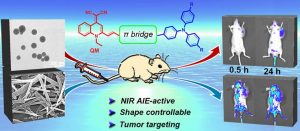Creating high performance nanomaterials in application of cancer diagnosis and therapy in vivo is a fascinating area of research. While the interdependent role of particle shape, size and surface chemistry is highly important, the shape effect of nano/microstructures in biomedical imaging is still less understood. Organic nanomaterials have also attracted significant attention owing to their excellent flexibility in synthesis and chemical modification. In particular, aggregation-induced emission (AIE)-active molecules exhibit highly bright fluorescence in aggregation while faintly in solution. It makes them ideally suitable for biosensing and imaging in vivo. All of these merits are believed to create small molecules to afford organic nanostructures with the desired morphology, and therefore performing ideal function in diagnosis or therapy.

To make organic nanoprobes with ideal biological geometries for remarkable tumor-targeted efficacy in vivo, Prof. Weihong Zhu and co-workers from East China University of Science & Technology (ECUST), China achieved a unique molecular design strategy by tailoring AIE-active organic molecules to realize preferable far-red to near-infrared (NIR) fluorescence, well-controlled morphology from rod-like to spherical, as well as tumor-targeted bioimaging . Overall, they have made a breakthrough to utilize organic AIE-active NIR nanoprobes in cancer therapeutics and diagnostics.
Through elongating the π-conjugated system, and changing the π-bridge from thiophene to 3,4-ethylenedioxythiophene (EDOT), the shape-tailored organic quinoline-malononitrile (QM) nanoprobes are biocompatible. Excitedly, the spherical shape of QM-5 nanoaggregates exhibits excellent tumor-targeted bioimaging performance after intravenously injection into mice, but not the rod-like aggregates of QM-2. This specific shape dependent tumor-targeting ability by small organic nanoaggregates provides a promising approach for constructing new type of tumor imaging and therapy platform in vivo.
















